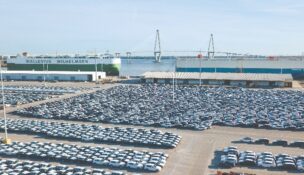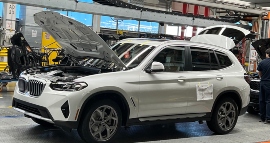Analysts: More vehicles on the road increases tire demand
Staff //November 19, 2019//
Editors Note: This story originally appeared in the Nov. 11, 2019 issue of GSA Business Report.
Brandon Mason, automotive director and U.S. mobility leader for PwC, has been involved in the automotive industry most of his career and said “this is by far the most complex time that I’ve ever been involved in.”
Mason made that comment at the S.C. Manufacturing Conference and Expo in Charleston during his talk about the auto industry now and in the future. He said even with growing interest in autonomous vehicles and new technologies, the kind of vehicles we drive now will still dominate.
“Privately-owned, human driven vehicles are still going to dominate our landscape for the foreseeable future,” he said, adding that his forecast out to 2025 shows growth of roughly 15 million units globally between now and the end of that forecast window, “which brings us to a global vehicle production forecast of 108 million vehicles,” he said.
“And I can tell you a vast majority of those are going to be combustion engine vehicles and human driven vehicles,” he said.
Of the 15 million units expected to be produced between now and 2025, Mason said nearly 60% of the growth will be in the Asian-Pacific market, and most of that in China, which is the world’s largest automotive market, he said.
“The U.S. sales market is down about 2% to 2.5%, so we will see a sales decline this year,” he said. “We would’ve seen a sales decline last year if not for the few hurricanes we had down in Florida and further southeast resulting in a significant vehicle volume that needed to be replaced.”
Mason said uncertainty in Europe, trade and tariff talk and the regulatory environment are creating headwinds for the industry.
“We do know something is coming at some point and we’re really nearing peak auto as we see it right now,” he said. “Still, we’re forecasting 2019 sales of 16.8 million units. That’s still a very strong number historically speaking.
“We do think those headwinds will increase into next year, so we have lowered our forecast for 2020 to around 16 million units,” he said, adding that the number isn’t bad news for the industry, “especially those that lived through the Great Recession of 2009 when we were getting down to the 10 million unit range.”
Activity in the automotive industry impacts the tire industry. Trade uncertainty in key continues to cloud near-term outlook, according to Kevin Roberts, global automotive senior analyst for Ernst & Young, who also spoke at the conference.
Roberts said the key trends impacting the tire industry are:
- Global trade: Trade uncertainty in key markets such as China, the United States and Europe continues to cloud near-term outlook.
- Regulation: Regulations are evolving to ensure safety, performance and sustainability.
- Raw materials: Tire makers are looking for alternate sources of raw materials as increasing rubber prices continues to pressure margins.
- Pricing: The retail prices of most tire makers are deteriorating on a year-over-year basis, while sequential price trends remain stable.
Roberts said his research is showing a growing number of vehicles on the road. And vehicle numbers “are a good indication of what the demand for tires is.”
“The more vehicles on the road the greater the demand for tires,” he said.
Second to how many vehicles are on the road is how often the vehicles are being driven.
“Coming out of the Great Recession we noticed people are driving more miles than ever. Right now we’re on track to have the highest number of miles ever driven in the U.S.,” he said. “So, this is good news from the tire industry point of view. We’ve got more vehicles on the road than ever and they’re being driven more miles than ever before.”
e

















